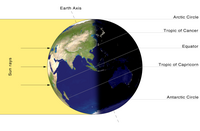June solstice

Hey kiddo, do you know that we have four different seasons throughout the year? These seasons happen because the way the Earth moves around the Sun changes the amount of sunlight and warmth that different parts of the planet experience.
One of the most important days that marks the beginning of a new season is called the solstice. The word solstice actually means "sun stands still," and it happens twice a year - once in June and once in December.
The June solstice is the day of the year when the Earth's North Pole is tilted closest to the Sun, causing the longest amount of daylight hours (which also means the shortest amount of nighttime hours) in the northern hemisphere. This happens around June 20th or 21st each year, depending on where you are in the world.
So, on the day of the June solstice, if you live in the northern hemisphere, you'll experience the longest day of the year with lots of bright sunshine shining down on you. This is a really exciting time for many people because it means summer has officially arrived!
Meanwhile, if you live in the southern hemisphere, you'll experience the shortest day of the year on this same date. This is when winter officially begins down there.
So isn't that cool? Just by how much the Earth is tilted, we have different weather all around the world. It's amazing how the world works, isn't it?
One of the most important days that marks the beginning of a new season is called the solstice. The word solstice actually means "sun stands still," and it happens twice a year - once in June and once in December.
The June solstice is the day of the year when the Earth's North Pole is tilted closest to the Sun, causing the longest amount of daylight hours (which also means the shortest amount of nighttime hours) in the northern hemisphere. This happens around June 20th or 21st each year, depending on where you are in the world.
So, on the day of the June solstice, if you live in the northern hemisphere, you'll experience the longest day of the year with lots of bright sunshine shining down on you. This is a really exciting time for many people because it means summer has officially arrived!
Meanwhile, if you live in the southern hemisphere, you'll experience the shortest day of the year on this same date. This is when winter officially begins down there.
So isn't that cool? Just by how much the Earth is tilted, we have different weather all around the world. It's amazing how the world works, isn't it?
Related topics others have asked about:
